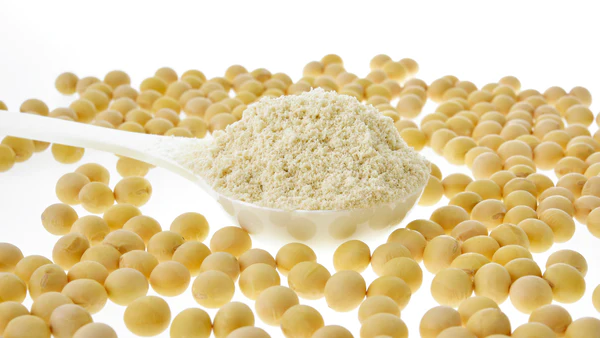
Soybean protein is a plant-based protein with good amino acid balance characteristics. It is rich in 8 kinds of essential amino acids required by the human body. When the quality of protein is expressed by the score, soybean protein and animal protein are the same; compared with animal protein, soybean protein has a health care effect on the kidneys, and replacing animal protein with soybean protein can reduce the excretion of calcium in the urinary system.
The wheat flour milling process removes the bran and germ with high nutritional value, and only retains the endosperm with starch as the main component, resulting in low nutritional value of flour products. Wheat flour is rich in cysteine and methionine, and lacks lysine. acid, while the content of lysine in soybean protein is relatively high, and the content of cysteine and methionine is low, which just forms a complement. The lipoxygenase contained in soybean flour can interact with the carotene in wheat flour, so that the color of carotene gradually fades away, thereby increasing the effect on noodle products. At the same time, lipoxygenase acts on the hydrogen produced by fat. Oxides can also oxidize -SH of wheat gluten to -S-S-, strengthen the three-dimensional structure of gluten, and enhance the gluten strength of flour products. Soy protein has functional properties such as water holding capacity, gelatinity, and oil absorption, which can make gluten more delicate and elastic, and improve the processing characteristics and sensory properties of noodle products. Therefore, adding an appropriate amount of soybean protein to flour products can not only improve the nutritional value of flour products, but also improve their quality to a certain extent.
1. Defatted soy protein powder
Defatted soybean protein powder is mainly obtained by pulverizing defatted soybean meal. The fat content does not exceed 1.0%, and the protein content exceeds 50%. Compared with other soybean protein products, its production process is simple, the cost is low, and it is rich in human body needs. A variety of amino acids, isoflavones, other nutrients and biologically active substances. Therefore, defatted soybean flour is the most ideal protein additive in the food industry, and is widely used in meat products, milk and egg substitutes, bread, cakes and other foods to improve product flavor.
2. Low-fat soy protein powder
Low-fat soy protein powder is obtained by dry-pressing soybeans or dehulled soybeans at their natural moisture content, and then immediately passing through a horizontal press to separate the oil from full-fat soybean meal. The fat content of low-fat soy protein powder is At about 5%, the protein content is generally 45% to 50%, which can be used as food raw materials for various products, especially in baked goods.
3. Full fat soy protein powder
Full-fat soybean protein powder is made by grinding or grinding dehulled soybean products, so its composition is the same as that of soybean cotyledons, with a fat content of about 20%, a protein content of about 40%, and a fineness of more than 80 mesh. In order to eliminate the naturally occurring anti-nutritional components in soybeans and minimize the beany smell produced by lipoxygenase in industrial production, whole soybeans are often heat-treated before grinding. In the food industry, full-fat soybean protein powder is mainly used as a protein supplement, a substitute for eggs and milk.
Soybean protein isolate is a high-purity soybean protein product obtained after further removing non-protein components contained in low-temperature soybean meal. Compared with concentrated soy protein, soy protein isolate not only removes soluble polysaccharides, but also removes insoluble sugars. points, so its protein content is over 90%. Soy protein isolate is mainly used in the food industry for nutritional bars, liquid beverages, meat products, extruded cereal products, diet foods, etc.
